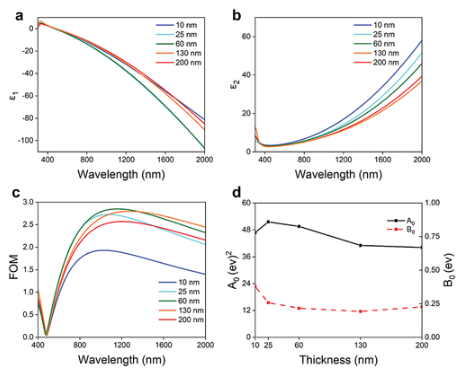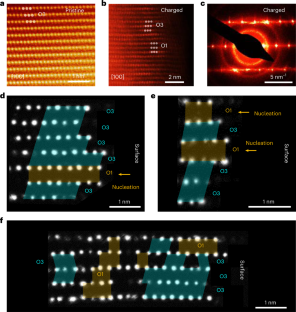2023-01-26 パデュー大学
◆パデュー大学の電気・コンピュータ工学部教授であるVladimir M. ShalaevとAlexandra Boltasseva、および当時のポスドク研究員Soham Sahaを中心とする研究チームは、ENZ点(材料が誘電でも金属でもない波長)を制御する方法を検討しました。光はENZ材料を通過するとき、その群速度がゼロ近くまで遅くなり、より長い時間材料と相互作用することができるようになる。このため、多くの興味深い非線形性が生まれます。しかし、従来のほとんどの材料では、ENZ点は固定されており、移動させることは困難であった。
◆今回、研究者らが示したのは、光学特性の厚み方向の関連付けは、最も簡単に操作できるものの1つであり、同じ成長環境で異なるENZ特性をもつ膜を成長させることができるということである。材料膜の厚さを調整し、ENZ領域付近での光吸収を制御することで、研究者は多くの異なる波長領域で絶対的なENZ物理を研究することができる。これにより、全光スイッチング、時間屈折、高次高調波発生など、さまざまな非線形光学現象が可能になる。
◆本研究は、Advanced Materials誌に掲載されました。アブストラクトはオンラインでご覧いただけます。
◆研究者らは、反応性マグネトロンスパッタリング法により、シリコン上に低損失の多結晶TiN膜を開発した。その上にパルスレーザー堆積法によりAZOを成長させた。彼らは、分光エリプソメトリー、原子間力顕微鏡、透過型電子顕微鏡によって、膜厚依存の光学特性の原因を調べ、光学特性とその構造特性を結びつけた。また、動的可変デバイスの概念実証として、バンド間ポンプを用いた共振器の全光学スイッチングを実証し、ピコ秒の緩和時間を示しました。
<関連情報>
- https://www.purdue.edu/newsroom/releases/2023/Q1/researchers-tailor-thickness-of-conducting-nitrides-and-oxides-to-enhance-their-photonic-applications.html
- https://onlinelibrary.wiley.com/doi/full/10.1002/adma.202109546
導電性窒化物および酸化物の厚みに依存した光学特性の調整によるε-ニアゼロ強化フォトニック応用への応用 Tailoring the Thickness-Dependent Optical Properties of Conducting Nitrides and Oxides for Epsilon-Near-Zero-Enhanced Photonic Applications
Soham Saha, Mustafa Goksu Ozlu, Sarah N. Chowdhury, Benjamin T. Diroll, Richard D. Schaller, Alexander Kildishev, Alexandra Boltasseva, Vladimir M. Shalaev
Advanced Materials Published: 02 August 2022
DOI:https://doi.org/10.1002/adma.202109546

Abstract
The unique properties of the emerging photonic materials, conducting nitrides and oxides, especially their tailorability, large damage thresholds, and, importantly, the so-called epsilon-near-zero (ENZ) behavior, have enabled novel photonic phenomena spanning optical circuitry, tunable metasurfaces, and nonlinear optical devices. This work explores direct control of the optical properties of polycrystalline titanium nitride (TiN) and aluminum-doped zinc oxide (AZO) by tailoring the film thickness, and their potential for ENZ-enhanced photonic applications. This study demonstrates that TiN–AZO bilayers support Ferrell–Berreman modes using the thickness-dependent ENZ resonances in the AZO films operating in the telecom wavelengths spanning from 1470 to 1750 nm. The bilayer stacks also act as strong light absorbers in the ultraviolet regime using the radiative ENZ modes and the Fabry–Perot modes in the constituent TiN films. The studied Berreman resonators exhibit optically induced reflectance modulation of 15% with picosecond response time. Together with the optical response tailorability of conducting oxides and nitrides, using the field enhancement near the tunable ENZ regime can enable a wide range of nonlinear optical phenomena, including all-optical switching, time refraction, and high-harmonic generation.



